Projects
Moravians developed a distinctive way to plan and build their settlements. They have established congregations and built such settlements across the Globe, always creatively adapting the planning and architectural ideas to local conditions while retaining the core principles.
The Moravian Settlement at Gracehill, like many other Moravian settlements around the world, is an early example of “town planning” and dates from 1759.

Moravian Settlement at Gracehill
It is the only complete Moravian Settlement in Ireland and the unique atmosphere and special qualities of Gracehill were recognised in 1975 when it was the first place in Northern Ireland to be designated a Conservation Area.
The conservation area contains sixteen listed buildings and planned green spaces and its form remains much as it did in the late eighteenth century. Gracehill is not just a historic site but it is significant because of its religious, cultural, social, educational, architectural and international associations.
It has also contributed to reconciliation during turbulent times in Ireland.
Much current thinking around Town Planning is concerned with “Place making” where the aim is to create places that people will enjoy and which will ultimately create the scenery and backdrop against which they will live their lives, places that are positive and uplifting and perhaps even inspiring, places with a narrative or stories that attract and sustain people. Clearly the early Moravians were experts at place making. They knew how to make people feel positive, they had a narrative and in establishing their settlements around the Globe they had a vision.
Against this background, such a significant and historic area as Gracehill requires care and attention to not only maintain it but also to enhance it while ensuring it meets the requirements of a modern community. In the early 1990’s Gracehill Environmental Improvement Association was established with representation from the Moravian Congregation, the local residents and Ballymena Borough Council. The Association was involved in a variety of activities including the production of the first “Gracehill Area Development Plan” in 1996 followed by a study the following year to look at possible improvements and enhancements.
In 2002 Gracehill Old School Trust (or GhOST as it became known) was established, incorporating the Environmental Improvement Association. Since this time there have been a number of further studies and plans but happily many of the enhancements suggested in the initial report have been realised. These include restoration and reuse of the Old School, restoration of the Square, the provision of some literature and signage, the installation of the Victorian postbox and restoration of the Old Shop building. In addition to all this a number of other schemes were proposed including the provision of walks or paths around the Village. These included:
- The 1798 walk around the Square (now completed.)
- A walk to include God’s Acre (now completed and known as “Bishops Walk”)
- A walk to connect the village to the nearby network of river paths and Galgorm Castle)
More details of the work of Gracehill Old School Trust can be found below
- The Old School
- The Square And 1798 Walk
- Bishops Walk And Jubilee Wood
- The Old Shop
- The Penfold Postbox
- Village Signage
Village Regeneration
Many other aspect of the village are being restored by other organisations and individuals. Examples include:
- Gracehill Moravian Church, Manse and Wardens House
- The Church Organ
- Former Single Brethren House (Montgomery Street) and many other private properties in the Conservation area.